Lianzheng Shi
Digital Twin Channel-Aided CSI Prediction: A Environment-based Subspace Extraction Approach for Achieving Low Overhead and Robustness
Aug 07, 2025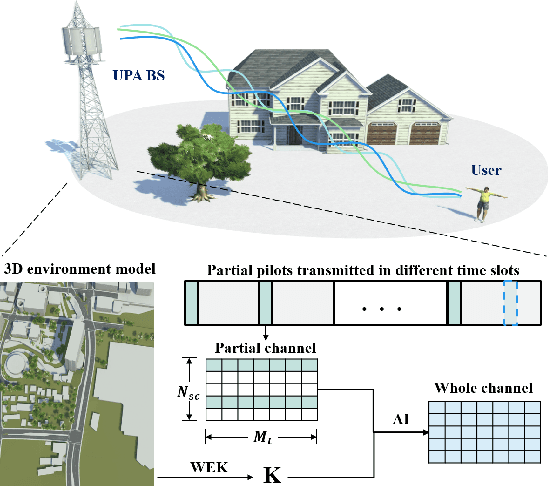
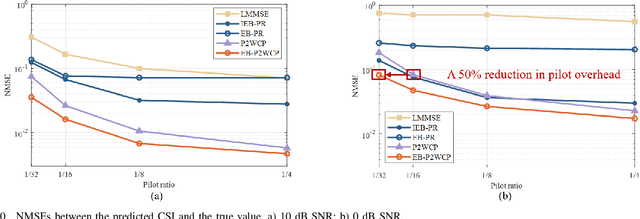
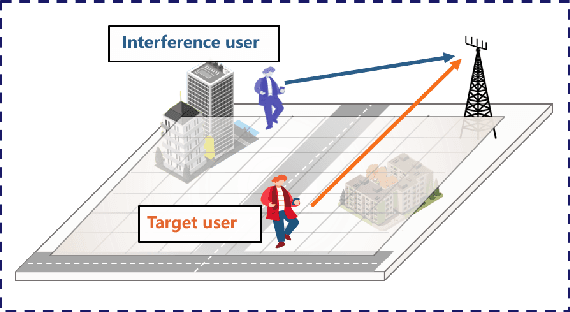

Abstract:To meet the robust and high-speed communication requirements of the sixth-generation (6G) mobile communication system in complex scenarios, sensing- and artificial intelligence (AI)-based digital twin channel (DTC) techniques become a promising approach to reduce system overhead. In this paper, we propose an environment-specific channel subspace basis (EB)-aided partial-to-whole channel state information (CSI) prediction method (EB-P2WCP) for realizing DTC-enabled low-overhead channel prediction. Specifically, EB is utilized to characterize the static properties of the electromagnetic environment, which is extracted from the digital twin map, serving as environmental information prior to the prediction task. Then, we fuse EB with real-time estimated local CSI to predict the entire spatial-frequency domain channel for both the present and future time instances. Hence, an EB-based partial-to-whole CSI prediction network (EB-P2WNet) is designed to achieve a robust channel prediction scheme in various complex scenarios. Simulation results indicate that incorporating EB provides significant benefits under low signal-to-noise ratio and pilot ratio conditions, achieving a reduction of up to 50% in pilot overhead. Additionally, the proposed method maintains robustness against multi-user interference, tolerating 3-meter localization errors with only a 0.5 dB NMSE increase, and predicts CSI for the next channel coherent time within 1.3 milliseconds.
Multi-Modal Large Models Based Beam Prediction: An Example Empowered by DeepSeek
Jun 06, 2025Abstract:Beam prediction is an effective approach to reduce training overhead in massive multiple-input multiple-output (MIMO) systems. However, existing beam prediction models still exhibit limited generalization ability in diverse scenarios, which remains a critical challenge. In this paper, we propose MLM-BP, a beam prediction framework based on the multi-modal large model released by DeepSeek, with full consideration of multi-modal environmental information. Specifically, the distribution of scatterers that impact the optimal beam is captured by the sensing devices. Then positions are tokenized to generate text-based representations, and multi-view images are processed by an image encoder, which is fine-tuned with low-rank adaptation (LoRA), to extract environmental embeddings. Finally, these embeddings are fed into the large model, and an output projection module is designed to determine the optimal beam index. Simulation results show that MLM-BP achieves 98.1% Top-1 accuracy on the simulation dataset. Additionally, it demonstrates few-shot generalization on a real-world dataset, achieving 72.7% Top-1 accuracy and 92.4% Top-3 accuracy with only 30% of the dataset, outperforming the existing small models by over 15%.
ChannelGPT: A Large Model to Generate Digital Twin Channel for 6G Environment Intelligence
Oct 17, 2024



Abstract:6G is envisaged to provide multimodal sensing, pervasive intelligence, global coverage, global coverage, etc., which poses extreme intricacy and new challenges to the network design and optimization. As the core part of 6G, wireless channel is the carrier and enabler for the flourishing technologies and novel services, which intrinsically determines the ultimate system performance. However, how to describe and utilize the complicated and high-dynamic characteristics of wireless channel accurately and effectively still remains great hallenges. To tackle this, digital twin is envisioned as a powerful technology to migrate the physical entities to virtual and computational world. In this article, we propose a large model driven digital twin channel generator (ChannelGPT) embedded with environment intelligence (EI) to enable pervasive intelligence paradigm for 6G network. EI is an iterative and interactive procedure to boost the system performance with online environment adaptivity. Firstly, ChannelGPT is capable of utilization the multimodal data from wireless channel and corresponding physical environment with the equipped sensing ability. Then, based on the fine-tuned large model, ChannelGPT can generate multi-scenario channel parameters, associated map information and wireless knowledge simultaneously, in terms of each task requirement. Furthermore, with the support of online multidimensional channel and environment information, the network entity will make accurate and immediate decisions for each 6G system layer. In practice, we also establish a ChannelGPT prototype to generate high-fidelity channel data for varied scenarios to validate the accuracy and generalization ability based on environment intelligence.
Can Wireless Environmental Information Decrease Pilot Overhead: A CSI Prediction Example
Aug 13, 2024



Abstract:Channel state information (CSI) is crucial for massive multi-input multi-output (MIMO) system. As the antenna scale increases, acquiring CSI results in significantly higher system overhead. In this letter, we propose a novel channel prediction method which utilizes wireless environmental information with pilot pattern optimization for CSI prediction (WEI-CSIP). Specifically, scatterers around the mobile station (MS) are abstracted from environmental information using multiview images. Then, an environmental feature map is extracted by a convolutional neural network (CNN). Additionally, the deep probabilistic subsampling (DPS) network acquires an optimal fixed pilot pattern. Finally, a CNN-based channel prediction network is designed to predict the complete CSI, using the environmental feature map and partial CSI. Simulation results show that the WEI-CSIP can reduce pilot overhead from 1/5 to 1/8, while improving prediction accuracy with normalized mean squared error reduced to 0.0113, an improvement of 83.2% compared to traditional channel prediction methods.
Towards 6G Digital Twin Channel Using Radio Environment Knowledge Pool
Dec 16, 2023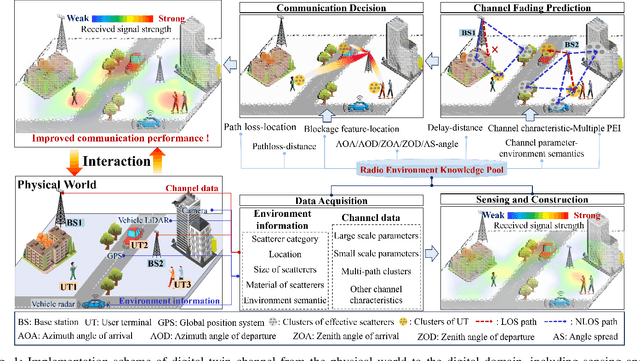

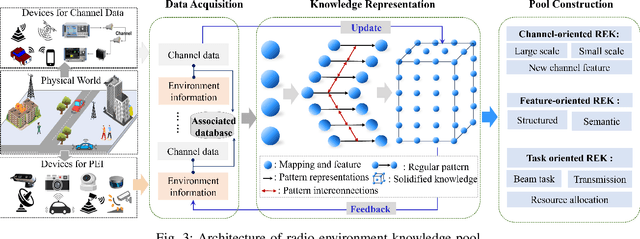
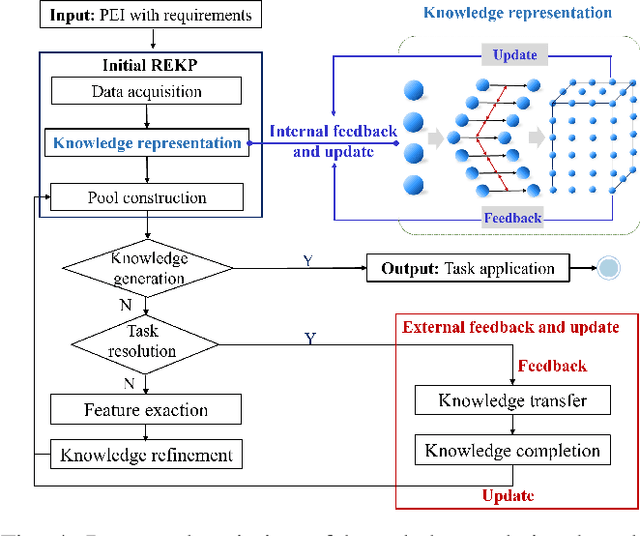
Abstract:DTC is a technical system that reflects the raw channel fading states and variations in a digital form at the virtual space, to actively adapt to novel communication techniques of the wireless communication system (WCS) at the physical or link level. To realize DTC, in this article, the concept and construction method of the radio environment knowledge pool (REKP) is proposed, which possesses the advantages of being controllable, interpretable, renewable, and generalized. Concretely, it is a collection that represents the regular pattern representations and interconnections between propagation environment information (PEI) and channel data. It also has the ability to update knowledge based on environment changes, human cognition, and technological developments. Firstly, the current state of knowledge-based research in the communication field and that for acquiring channel knowledge and achieving DTC are summarized. Secondly, how to construct and update REKP to conduct key communication tasks is given. Then, the typical cases with extensive numerical results are presented to demonstrate the great potential of REKP in enabling DTC. Finally, how to utilize REKP to address key challenges in implementing DTC and 6G WCS are discussed, including interpretability and generalization of DTC, and enhancing performance and reducing costs in the 6G WCS.
 Add to Chrome
Add to Chrome Add to Firefox
Add to Firefox Add to Edge
Add to Edge